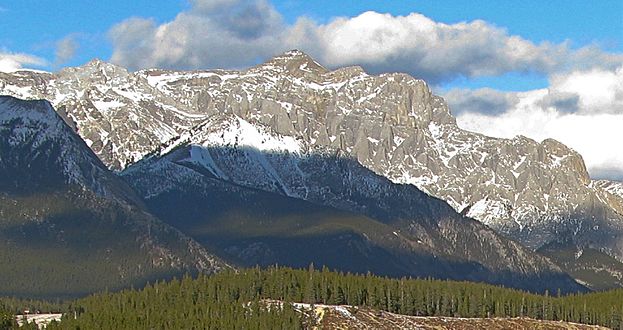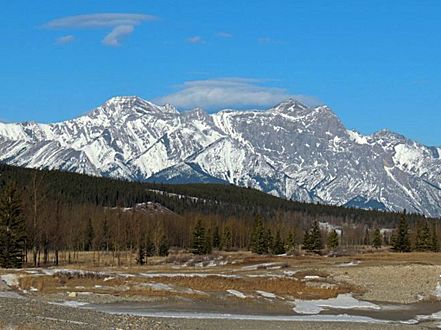Abraham Mountain facts for kids
Quick facts for kids Abraham Mountain |
|
|---|---|

Abraham Mountain
|
|
| Highest point | |
| Elevation | 2,820 m (9,250 ft) |
| Prominence | 160 m (520 ft) |
| Parent peak | Allstones Peak (2940 m) |
| Listing | Mountains of Alberta |
| Geography | |
| Location | Alberta, Canada |
| Parent range | Front Range Canadian Rockies |
| Topo map | NTS 83C/08 |
| Type of rock | Sedimentary |
Abraham Mountain is a mountain in the Canadian Rockies of Alberta, Canada. It stands about 2,820 meters (9,252 feet) tall. This mountain is located in the North Saskatchewan River valley.
The closest taller mountain is Allstones Peak, which is about 2 kilometers (1.2 miles) to the west. You can easily see Abraham Mountain from the David Thompson Highway and Abraham Lake. Rain and melting snow from Abraham Mountain flow east into Abraham Lake.
Contents
History of Abraham Mountain
Who was Abraham Mountain named after?
Abraham Mountain, like the nearby lake, is named after a man named Silas Abraham. He lived from 1871 to 1961. Silas Abraham was a member of the Stoney First Nation. He lived in the Kootenay Plains and the Saskatchewan River valley.
He worked as a guide for explorers. In 1906 and 1907, he helped Mary Schäffer explore the area. He also guided another explorer named Martin Nordegg.
What is Abraham Mountain made of?
The Rocks of Abraham Mountain
Abraham Mountain is made of a type of rock called sedimentary rock. This rock formed from layers of sand, mud, and tiny bits of dead plants and animals that built up over millions of years.
These layers were laid down during very old time periods, from the Precambrian to the Jurassic periods. Later, during a time called the Laramide orogeny, these rock layers were pushed up and over younger rocks. This process created the mountain ranges we see today.
Weather at Abraham Mountain
Climate Zone and Temperatures
Abraham Mountain is in a subarctic climate zone. This means it has very cold, snowy winters. The summers are usually mild.
Winter temperatures can drop below −20 °C (−4 °F). With the wind chill, it can feel even colder, sometimes below −30 °C (−22 °F).
Gallery





